The transition toward digital dentures is underway. Let’s take a close look at one of the most important attributes of dentures: teeth esthetics. While there are many opinions about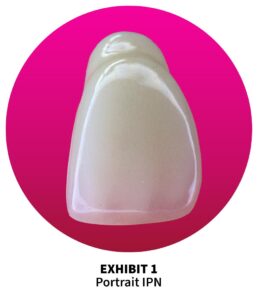 denture teeth esthetics, some norms have evolved in the American denture market. The maxillary central incisors are considered the most important teeth from an esthetic standpoint with natural and artificial teeth. Therefore, most denture teeth shade guides are molded from a maxillary central incisor. Shown in Exhibit 1 is a maxillary central from a premanufactured Portrait IPN tooth, mold 22E in shade A2. While esthetics are very subjective, there are a few key elements to esthetics preferred by North Americans, and all of them are present in the Portrait IPN tooth. First, a translucent incisal edge is a must on a maxillary central. In addition, translucency should extend around the mesial and distal corners and up into the interproximal areas. Second, mamelons (sometimes called “lobes”) should be barely visible, but they must exist. Mamelons are downward protruding structures that provide some natural irregularity and depth. Third, the neck of the tooth should be darker which means in color terms, a lower value. Fourth, surface translucency is critical. A translucent labial-buccal surface is critical to allow light to pass through to the layers underneath. And fifth, for central anteriors, the labial surface must be slightly undulating to reflect light - like ripples on a pond.
denture teeth esthetics, some norms have evolved in the American denture market. The maxillary central incisors are considered the most important teeth from an esthetic standpoint with natural and artificial teeth. Therefore, most denture teeth shade guides are molded from a maxillary central incisor. Shown in Exhibit 1 is a maxillary central from a premanufactured Portrait IPN tooth, mold 22E in shade A2. While esthetics are very subjective, there are a few key elements to esthetics preferred by North Americans, and all of them are present in the Portrait IPN tooth. First, a translucent incisal edge is a must on a maxillary central. In addition, translucency should extend around the mesial and distal corners and up into the interproximal areas. Second, mamelons (sometimes called “lobes”) should be barely visible, but they must exist. Mamelons are downward protruding structures that provide some natural irregularity and depth. Third, the neck of the tooth should be darker which means in color terms, a lower value. Fourth, surface translucency is critical. A translucent labial-buccal surface is critical to allow light to pass through to the layers underneath. And fifth, for central anteriors, the labial surface must be slightly undulating to reflect light - like ripples on a pond.
Now let’s look at teeth esthetics in a variety of digital dentures. I have established four categories so you can more clearly understand the differences (Exhibit 2).
Exhibit 2

The first category is 3D-printed teeth using the most common technology, DLP. The teeth are printed from a single material. The material manufacturers try to balance opacity so that the incisal edge appears translucent and the body more opaque. Most 3D print resins achieve this effect, but the translucency is limited to a horizontal plane. There is no translucency extending up and around the mesial and distal corners. Because 3D resins are printed as a single material, there are no mamelons present. There is a technique to reduce the thickness of the central incisor by adjusting the labial surface with vertical grooves to give the effect of mamelons, but it is ineffective. 3D-printed teeth do not have a 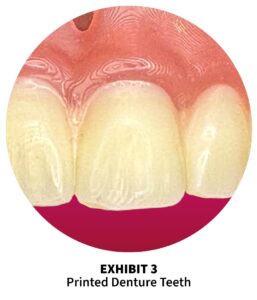 contrasting neck shade because the tooth is printed from a single-shaded material. There is some effect of the denture base creating the illusion of a darker neck, but again, it is not very effective relative to highly esthetic denture teeth. The surface translucency of 3D-printed teeth comes from the inherent translucency of the material. But because there is no second layer of contrasting color, there is a lack of depth resulting in a monochrome appearance. The labial surface is highly dependent on the finishing technique. That is, even if a digital process can produce a gently undulating surface, a technician finishing the denture may polish the surface flat, which is not ideal. But since a 3D-printed denture is printed in layers, the results can look like a topographical map as you can see in Exhibit 3. Finishing this surface to look like a denture tooth is very difficult without polishing off the anatomy.
contrasting neck shade because the tooth is printed from a single-shaded material. There is some effect of the denture base creating the illusion of a darker neck, but again, it is not very effective relative to highly esthetic denture teeth. The surface translucency of 3D-printed teeth comes from the inherent translucency of the material. But because there is no second layer of contrasting color, there is a lack of depth resulting in a monochrome appearance. The labial surface is highly dependent on the finishing technique. That is, even if a digital process can produce a gently undulating surface, a technician finishing the denture may polish the surface flat, which is not ideal. But since a 3D-printed denture is printed in layers, the results can look like a topographical map as you can see in Exhibit 3. Finishing this surface to look like a denture tooth is very difficult without polishing off the anatomy.
The next category of digital dentures I’m calling a milled single-layer approach. In this method, the teeth and base are milled separately and then luted together. Milling is a better technique to reproduce a digital denture design because the result is 100% to size without distortion. But since we are focused on tooth esthetics, let’s discuss the pros and cons of this approach. The incisal translucency is dependent on the inherent translucency of the single layer of material which is normally poly methyl methacrylate, or, PMMA. Just like 3D printed resins, in order to achieve a translucent incisal edge, the manufacturer has to balance the translucency desired at the incisal edge with the opacity desired in the body and neck of the tooth. Many PMMA single-layer milling pucks achieve this effect, but the translucency is limited to a horizontal plane. Just like printed resins, there is no translucency extending up and 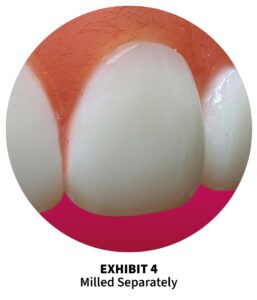 around the mesial and distal corners. In the categories of mamelons, neck contrast, and surface translucency, I rate this single-layer milled approach the same as printed resins because both techniques have limitations due to the single layer of material. The finished labial surface has the potential to be slightly better in a milled solution compared to 3D printing because the raw surface is generally smoother and does not require as much manual finesse in the final polishing phase. However, a milled surface is not as smooth as can be produced from a steel mold which is how denture teeth are produced.
around the mesial and distal corners. In the categories of mamelons, neck contrast, and surface translucency, I rate this single-layer milled approach the same as printed resins because both techniques have limitations due to the single layer of material. The finished labial surface has the potential to be slightly better in a milled solution compared to 3D printing because the raw surface is generally smoother and does not require as much manual finesse in the final polishing phase. However, a milled surface is not as smooth as can be produced from a steel mold which is how denture teeth are produced.
The next category is milled teeth from a multi-layered puck. Multi-layered pucks are more expensive to produce because there are typically 8 to 16 layers of material that go from translucent to more opaque in a horizontal fashion. They are made by stacking thin layers – like round slices of cheese – on top of one another. This approach can yield a slightly better-looking incisal edge compared to single-layer materials because the digital denture can be positioned in the puck so that the incisal edge of the central anteriors is in the ideal position. However, the translucency is limited to a horizontal plane. There is still no translucency rounding the mesial and distal corners and up into the interproximal areas like high-quality denture teeth. While the translucency of the centrals is improved over the single-layer approach, the laterals - which are typically raised from the centrals – are not ideally positioned to show the optimal translucency. In this approach, there is still no ability to create the effect of mamelons in the central incisors. The neck contrast effect of multi-layered tooth material is an improvement because the neck shade can be significantly darker and more opaque vs. the incisal edge. However, the effect is completely horizontal. Like 3D-printed and single-layer milled teeth, there is no surface layer of translucency. Any variation of translucency in a multi-shaded puck is limited to a horizontal fashion. As a result, there is a lack of 3-dimensional depth perception which makes the teeth look flat.
The next category is a monolithic approach to milling layers that are customized for each tooth. The only company making digital dentures this way is AvaDent. 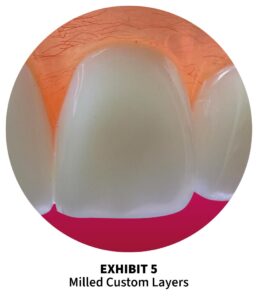 It solves most of the limitations of the other approaches. The dentin layer is formed with mamelons in the central incisors and the enamel layer is formed over the dentin layer so that there is a translucent layer over the entire labial-buccal surface of each tooth. This results in the incisal edge of all teeth displaying a translucency that matches esthetic denture teeth. For example, the translucent zone can be found transitioning around the mesial and distal edges of each tooth. The mamelons in each set of anterior teeth are formed by the dentin layer. Using AI, the geometry of the mamelons automatically changes when the teeth are sized up or down – so the overall appearance is consistent for the tooth mold selected. The neck contrast in color value comes from the denture base because the surface layer of the tooth is translucent. Compared to the Portrait IPN tooth, the contrast is not quite as pronounced because the Portrait IPN tooth has an additional layer of darker shaded material around the neck of the tooth. The surface translucency of milled custom-layer denture teeth mimics a premium carded denture tooth because most of the whole labial surface is covered with a layer of translucent enamel. Labial surfaces from milled or 3D-printed dentures must be polished to eliminate layering or tool marks. Premanufactured denture teeth are typically not polished as aggressively, thus generally having a superior labial surface.
It solves most of the limitations of the other approaches. The dentin layer is formed with mamelons in the central incisors and the enamel layer is formed over the dentin layer so that there is a translucent layer over the entire labial-buccal surface of each tooth. This results in the incisal edge of all teeth displaying a translucency that matches esthetic denture teeth. For example, the translucent zone can be found transitioning around the mesial and distal edges of each tooth. The mamelons in each set of anterior teeth are formed by the dentin layer. Using AI, the geometry of the mamelons automatically changes when the teeth are sized up or down – so the overall appearance is consistent for the tooth mold selected. The neck contrast in color value comes from the denture base because the surface layer of the tooth is translucent. Compared to the Portrait IPN tooth, the contrast is not quite as pronounced because the Portrait IPN tooth has an additional layer of darker shaded material around the neck of the tooth. The surface translucency of milled custom-layer denture teeth mimics a premium carded denture tooth because most of the whole labial surface is covered with a layer of translucent enamel. Labial surfaces from milled or 3D-printed dentures must be polished to eliminate layering or tool marks. Premanufactured denture teeth are typically not polished as aggressively, thus generally having a superior labial surface.
Considering our comments above, here are “grades” for teeth esthetics for the four types of digital dentures relative to the Portrait IPN tooth (Exhibit 6). The milled custom-layer teeth (AvaDent) are the best esthetic tooth option for digital dentures.
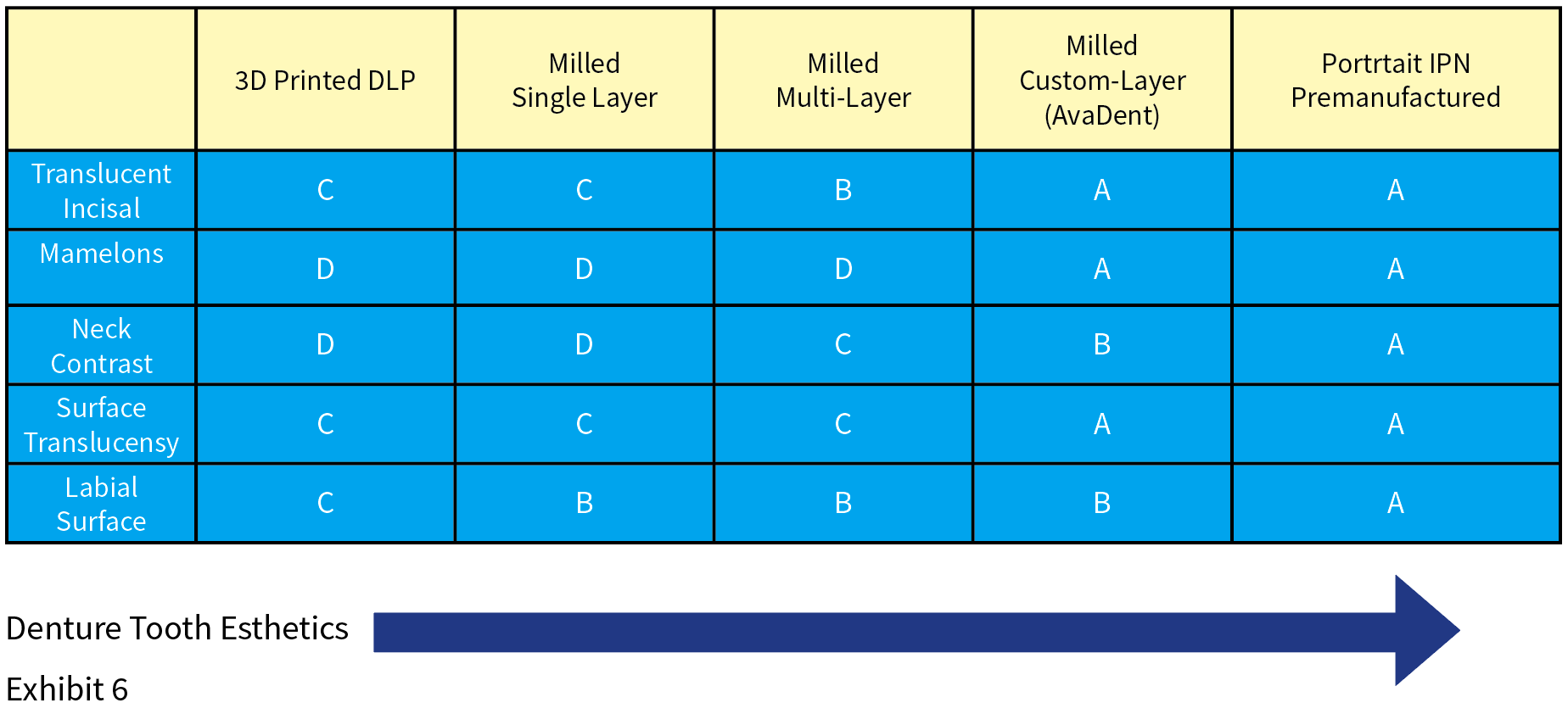
All images were taken with an iPhone14 macro lens.


